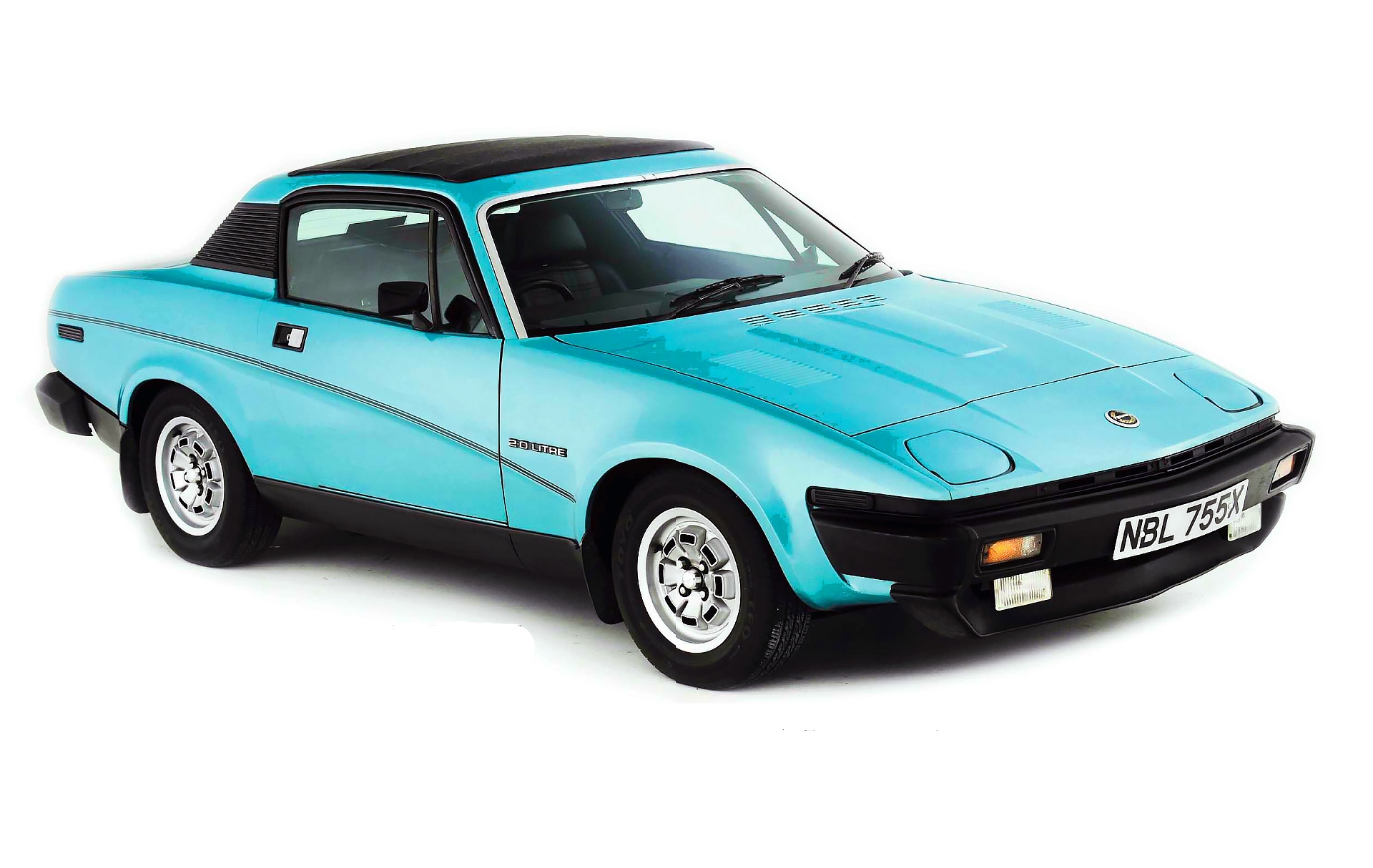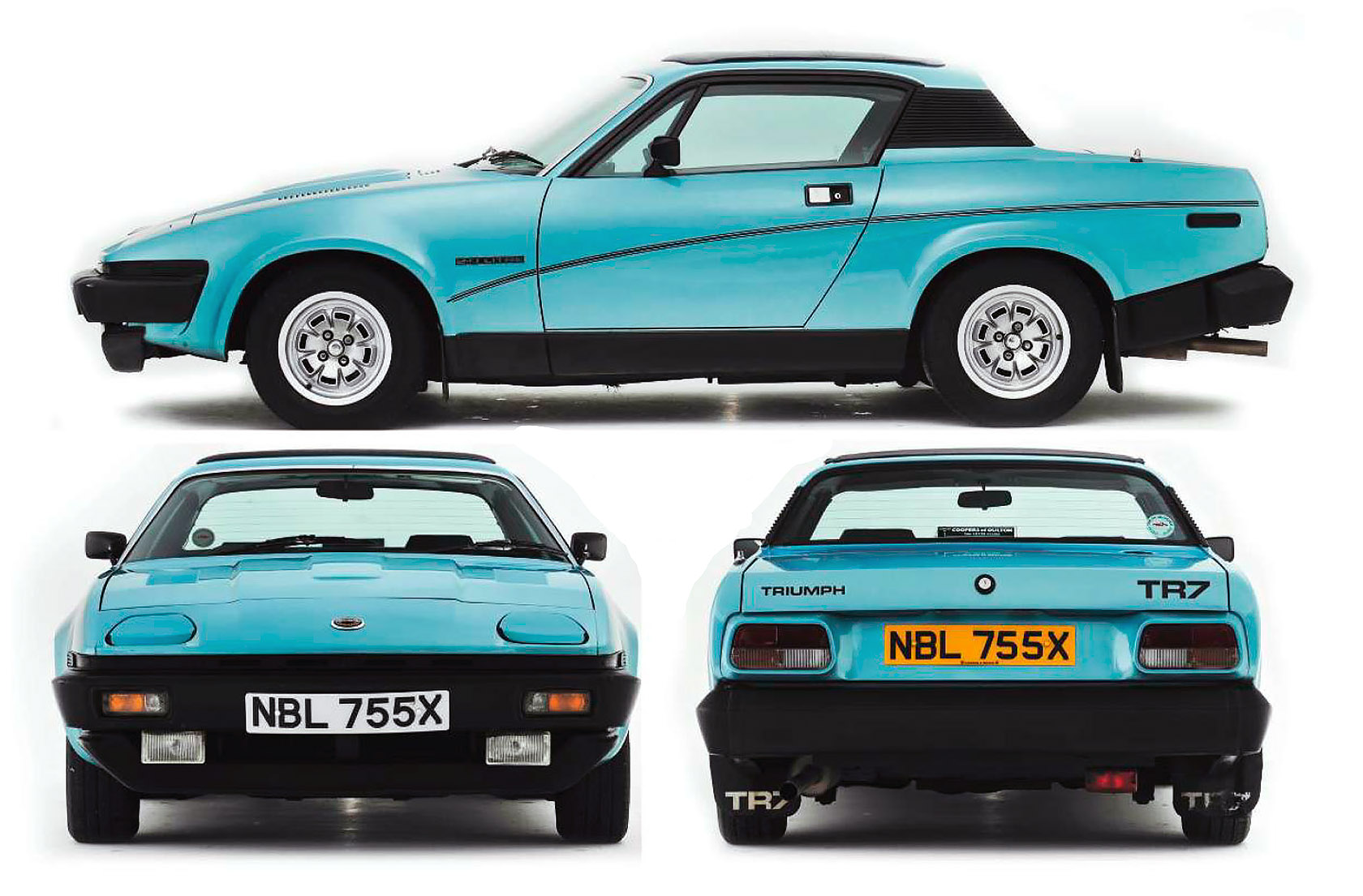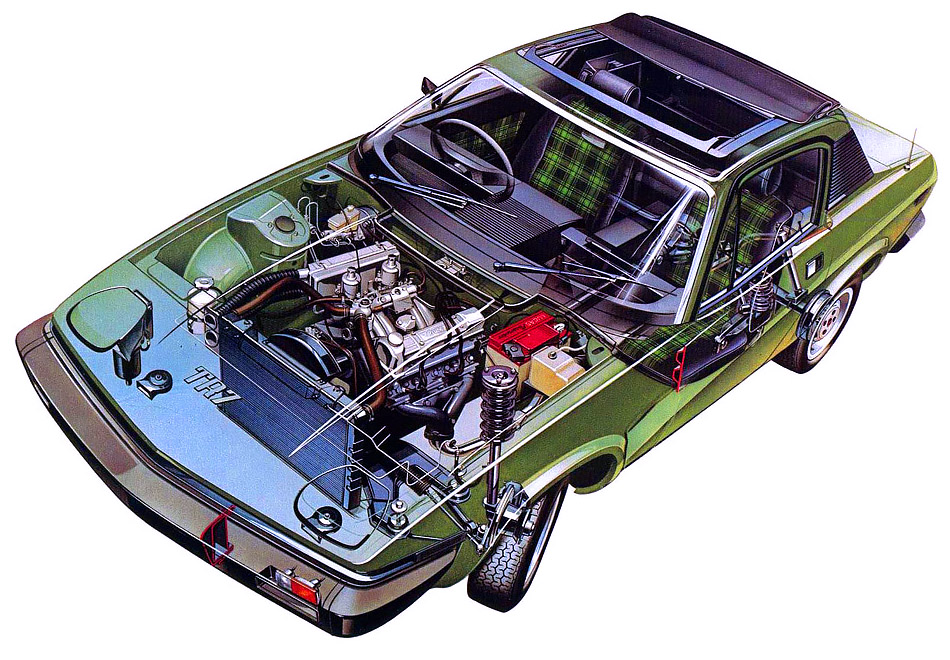
Buying guide Triumph TR7 – 5 steps too buying best Triumph TR7. It offers cheap access to Seventies cool, if you buy well. Here’s how. Words: Paul Hardiman. Photos: Tom Wood.
Our experts
Wayne Scott has owned TR7s for many years. He currently has a Grinnall-bodied V8 but previously ran a 2.0-litre as an everyday car covering nearly 50,000 miles during his tenure. As press and PR officer of the TR Register, the largest car club dedicated to all Triumph TRs, he looks after the rare, club- owned Coca-Cola Levi’s promotional TR7.
John Lucas served his apprenticeship in a BL dealership from 1982 as the last TR7s were being cleared. He got his first, a 79 Canley-built fhc, in 1986 and converted it to V8 using factory parts. Then came a Solihull drophead, followed by a 76 Speke-built fhc, one of the earliest cars known, that’s been converted back to a four- speed but with overdrive. ‘So, one from every factory! They’re fun to own, have lots more room than a MGB and are comfier to drive – and they’re cheaper.’
They say life begins at 40. Maybe it does – the much-maligned TR7 is finally becoming rehabilitated as a proper British sports car, just as it simultaneously approaches the age of maturity and becomes an increasingly rare sight on our roads. Tragically, so many have been scrapped because of low values, that there are only an estimated 1000 or so on British roads out of 27,000 home-market cars manufactured, and another 88,000 built for export. Here’s what to look out for to snap up one of the survivors while they’re still £2500-£5000.
1 BODYSHELL. Like all classics, body restoration is the most expensive aspect and because TR7 values are so low it’s not financially viable to rebuild them extensively. This is compounded by the fact that everything on the TR7 body is welded on – no easily replaced front wings here – and some areas of the body are double-skinned, which traps moisture and promotes widespread rust.
‘Start from the rear of the car by looking at the back of the sills, underneath, as you would with any classic,’ says Wayne Scott of the TR Register. ‘You don’t want to see oversills that simply hide a crumbly mess inside.’ Proper full-length sills continue behind the front wing.
{gallery}TR7{/gallery}
‘In front of the rear axle, check where the trailing arms mount to the floor – it’s a high-stress area, and very difficult to repair. Get the seats forward and pull the carpets back – you don’t want to see any stress cracks, creases or rust holes.’
Behind the rear wheels, check the wells at the bottoms of the wings aren’t full of water, especially on the radio antenna side, and that the drain holes are clear. The same goes for the spare wheel well.
The much-maligned TR7 is finally becoming rehabilitated as a proper British sports car
Moving forward, the front strut towers on the inner wings are the next most crucial sections – lots of cars, including our featured car, will have been Waxoyl-treated from new, which helps – then the flitch plates that run back to the bulkhead. ‘If these are rusted it’s a difficult, expensive repair, so you should walk away,’ says Scott.

Body and underside rust check should preoccupy any potential buyer. Enamel nose badge marks this out as a late, Solihull-built car
‘If the owner will let you, remove the black cover panel under the windscreen to get a good look at the bulkhead – if rust has started there it’s bad news. And check this from the other side, via the footwells. While you’re there, lift up the carpets and check there’s no corrosion where the floorpans meet the inner sills and footboards.
‘Also, rust begins in the seams where the headlight surround joins the front wings, and where the rear deck meets the rear wings. This is more of a problem on the coupe, where the wing is higher than the deck. The aluminium pop-up lights are operated by two wiper motors – simple.

Unusually, all panels are available – Rimmer Bros, for example, sells a complete body restoration kit for £1330 that includes wings, sills, doors, front apron and sundry repair sections. ‘The labour needed makes these cars expensive to repair which keeps TR7 values low,’ says Scott.
Obviously, if you’re looking at a restored car, as many of them will be by now, ask to see detailed photographs of the work carried out so you can satisfy yourself that all the rust has been banished.
2 THE SLANT-FOUR ENGINE, with linered cylinders, is a large-bore version of the 1850 Dolomite unit, and cylinder heads are known to be a problem if the car has overheated. New heads aren’t available, though you can still buy cylinder blocks for £465 each.
Wayne Scott says, ‘Getting the head off is the biggest problem, as the [five] angled studs rust into the block, and the aluminium head “grows” and sticks to them.’ Specialist companies have devised special tools that clamp to the head and push it off the studs.
‘Check that the cooling system has been maintained with a nice clean 50/50 mix of anti-freeze and water. They should run at about a quarter of the way up the temperature gauge at speed, and up to halfway up the gauge in traffic. If the head gasket is going, they run hot – so if the gauge is up to three-quarters the head is about to part company with the block.
‘Also check the drain slot next to the water pump. If it’s weeping, the pump has failed, so don’t drive the car because it will empty the cooling system very quickly and warp the cylinder head. Early cars have translucent plastic expansion bottles, later cars have a steel header tank.’
Continues Scott, ‘Water pumps were a real failing when new and there’s now no new-old stock left, so the replacement pumps that are available have often been reconditoned for the third or fourth time. If you have to change the pump it’s well worth spending the £200 or so for a guaranteed part from one of the main TR7 specialists [see ‘Who Can Help’, opposite page].’ Rimmer Bros’ price is £227, and bear in mind the design changed from six-vane to 12-vane in 1978. Top tip: a slide hammer helps to get it off the cylinder block.
‘If the cylinder head has to come off it’ll need a skim before it goes back on – they sometimes warp like a banana. The trouble is, they can only take one skim because the casting thickness is marginal, so if yours has already had this done you’ll be looking at a secondhand replacement.’
Scott reports no latent problems with the crankshaft, conrods and pistons, though British Leyland recommended changing the timing chains at 40-50,000 miles, so make sure this has been done. ‘You’ll know if it needs a new chain because worn ones rattle like castanets.’
The shim-under-bucket valvetrain usually holds its clearances pretty well. ‘They all tolerate unleaded fuel because they were built for the American market.’
Oil leaks are a normal British sports car feature, though not usually enough to need frequent topping-up. So if you buy the car invest in a big tray for the garage floor.
MEET THE OWNER
’I’ve cosseted it and it has never let us down’
Dick Tudhope
Dick has been the proud custodian of this 1981 Solihull-built fixed-head for three years, and it’s his first classic, if you don’t count the 286bhp Sierra XR4is he ran as company cars (They paid for the car, I paid for the conversion…’) or the 1934 Aston Martin 2.0-litre short chassis that he and his father rebuilt and then sold in 1957 for a princely £386. ‘Now it would be more like £386,000,’ rues Dick.
‘Seven or eight years ago a friend bought two TR7s – a drophead for himself and a fixed- head for his wife but after moving house they ran out of space. So they decided I should look after his wife’s car, but no money was to change hands. That was handy, because the bottom had fallen out of the van that I use for work as a mole catcher and I had the space – you can’t have a better friend than that.
‘We really enjoy being in it and we’re off nearly every weekend in it – I’ve cosseted it, changed all the pipes and had the passenger door refinished and it has never let us down.’ Dick’s not bluffing: he drove the car through the rain the 100-odd miles from home near Ross-on-Wye to our studio shoot in Hampshire. ‘Last year at the TR Register’s International Weekend at Malvern we were second overall in the pride of ownership awards, which was a bit scary.’
3 GEARBOX/ REAR AXLE. The five- speed from 1978 is the 77mm box shared with the Rover SD1 and Range Rover, and it’s tough. A baulkiness from cold, especially into second gear, is normal so don’t panic about this on the test-drive. Wayne Scott advises using automatic transmission fluid instead of hypoid oil to cure this – as BL did in period – while the TR Register site suggests a 75w90 semisynthetic gear oil is the best compromise.
The four-speed is the 1850 Dolomite box, and they always had weak synchromesh, almost non-existent on first,’ says Scott. If it’s noisy or popping out of gear it’s a good bargaining point, because a rebuilt box doesn’t cost the earth: £320 exchange. Rear axles on four-speed cars are weak and can whine, but used replacements arc available, as are reconditioned exchange units at £490.
4 INTERIORS. Surprisingly, they’re not a problem because everything is available either secondhand or even new: more parts, including dash mouldings, are remade by specialists. Complete interior kits start at around £1000, available in either vinyl, wool or leather. If the hood is in tatty condition, don’t worry but use it as a bargaining point. New covers, available in a range of colours, start at £240 for vinyl and £455 for mohair. A new vinyl cover on a reconditioned frame is £630.
5 WHEEL SHIMMY. Ah, the famous TR7 trait that drives some owners crazy. Nobody knows quite what causes it, but use it as a bargaining point because making sure all the suspension bushes are in good shape is the first step in eradication, and a set of inner track control arm and anti-roll bar bushes is £34 (about £60 in polyurethane).
But you might be luckier than Scott. ‘On my first one I couldn’t get rid of it and had to live with it, and on other cars it’s cured simply by balancing the wheels or changing to a different size. Don’t forget that the front suspension is on a subframe and so its mounting bushes need checking too (£26.50 standard, £48.50 hard or £60 polyurethane). But don’t be put off if you see large aluminium spacers, which are an antidive modification.’
IMPROVING
Electric fan. The viscous fans don’t give trouble,’ says Wayne Scott. ‘But the TR7 has a fairly small radiator and you’re more likely to be caught in traffic now than when the cars were new, so spending £100 on a Kenlowe electric fan is a good idea. A reconditioned, uprated four- row radiator is £245 from Rimmer Bros. Electronic ignition. Or at least a trigger system such as an Aldon Ignitor that replaces the points. It’s all about access. The distributor is a pain to get to,’ says Scott. ‘You need at least a specially bent 11mm spanner to adjust the timing, and it’s very fiddly to get to the points. Fit an electronic system and forget.’
Better brakes. TR7 braking is described by owners as ‘a bit marginal’. The usual fix is four- pot calipers from an SD1 or Austin Princess, or the M16 calipers from the Ford Capri/Cortina.
NEED TO KNOW
Cylinder heads Recons complete with camshaft and valves are available for £426 from Robsport International: £582 from Revington TR.
Timing chains costs about £180 to change, but can be done at home with a timing chain kit (£85 including sprockets from Rimmer Bros).
Who can help
Rimmer Bros rimmerbros.co.uk Revington TR revingtontr.com S&S Preparations ss-preparations.co.uk Robsport International robsport.co.uk TR Registertr-register.co.uk TR Drivers’ Club trdrivers.com
1980 TR7 £3000
Described as: ‘One owner 32 years. First respray just completed. Includes new radiator, windscreen, stainless steel exhaust. Really good condition. Full year’s MoT.’
WHICH ONE?
There are three distinct species of TR7, depending on where they were built: Speke, Canley or finally Solihull, with the later cars generally better built and seen as more desirable. The easy way to ID them is the nose decal: Speke cars, all four-speed fixed heads, have a ‘TR7’ sticker; Canley cars sport a laurel leaf with ‘Triumph’ script through the middle; Solihull cars have an enamel badge. Cars with a recessed boot lock are likely to be ex-Canley. Early models had a square ‘BL’ badge on the front wing (now often missing); Solihull cars should have a plastic ‘2.0 litre’ badge instead.
The first Speke cars were built at the height of BL’s quality troubles. More than 200 improvements were made when production moved to Canley in 1978, including a new source of steel for bodies. Solihull (1980-on) cars are considered to have stood the test of time best and will also be the youngest.
SPECIFICATIONS
1975-1981 Triumph TR7
Engine 1998cc sohc inline four-cylinder with two SU HS6 carburettors
Power and torque 105bhp @ 5500rpm; 119lb ft @ 3500rpm
Transmission Four- or five-speed manual
Steering Rack and pinion
Suspension Front: MacPherson struts, track control arms, anti-roll bar.
Rear: live axle, coil springs, trailing and semi- trailing arms, anti-roll bar. telescopic dampers
Brakes Discs front, drums rear
Weight 1000kg
Performance
Top speed: 110mph; 0-60mph: 9.1sec
Fuel consumption 26mpg
Value now MoT-able cars can be found from £800-£1500. and decent convertibles from £3000 up. As Wayne Scott says, ‘TR7s are hard to value – some years good drop-heads are £5000, and £2500-£3000 the next.’
Convertibles traditionally commanded more but coupes are now so rare, they’ve caught up. Bizarrely, the very rarity of the ‘worst’ cars, the Speke four-speed fixed-heads, now confers an arcane cachet that can inflate prices artificially.
The best cars are £5000-£6000, as will be anything with a V8. even though these will almost always be modified cars. Grinnall V8s command more than later conversions, with factory V8s there were only 18 UK-spec right-handers – being proper collectors’ cars and therefore £10.000-15,000. The less sought-after US-spec cars are £6000-£10,000.





